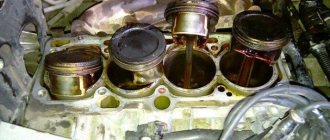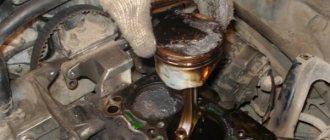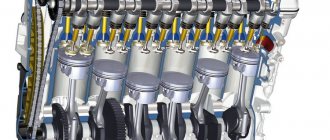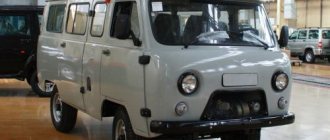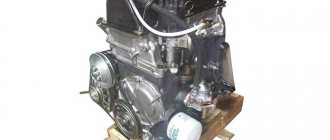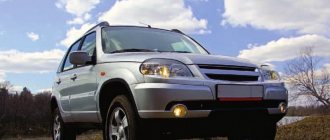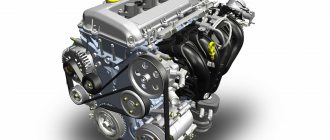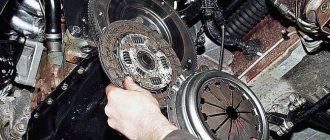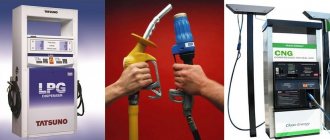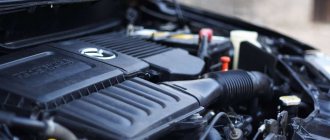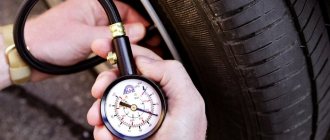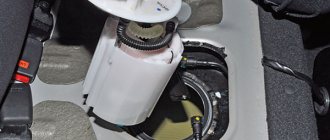Thermal clearance of piston rings
PCs are spring discs with one cut - when installed on the piston, they expand, and in the sleeve they are pressed tightly against its walls. In order to achieve maximum compression of the working mixture, the cylinder walls must be as smooth as possible (without defects), and the shape of the internal cavity must be perfectly round. On the piston, the PCs are placed in special grooves, moreover, they are not seated tightly, and on a cold piston they move freely in the grooves.
Piston rings have thermal clearances:
- between PC and groove;
- at the junction.
The clearances must be certain; if they are larger or smaller than the required value, the piston group will quickly fail. One should take into account the fact that when heated, the metal expands, and if the thermal gap of the PC is too small, the piston group will begin to overheat. With large gaps, tightness is not ensured and power losses occur.
For passenger cars, as a rule, the following clearances are established:
- between the grooves and the PDA - from 0.02 to 0.08 mm (for the upper ring the gap should be slightly larger);
- between grooves and MPC – from 0.05 to 0.06 mm;
- at the junction - from 0.25 to 0.5 mm.
As wear occurs, the gaps in the PC increase, and they should not exceed:
- between the ring and the groove – 0.15 mm;
- at the junction – 1.0 mm.
Gap between liner and piston
Parts of the D-240 cylinder-piston group of the MTZ-80 tractor are replaced with increased crankcase oil consumption or increased penetration of gases into the diesel crankcase, measured by diagnostic means. If the diagnostic parameters reach values exceeding the permissible ones, then the diesel engine is disassembled.
To carry out a technical examination of the parts, the cylinder head and oil pan are removed. If, after removing the head, cracks are found on the surface of the block, then further disassembly is stopped, the diesel engine is removed from the tractor and sent for repair.
If there are no obvious defects, dismantle the oil pump, pipelines and connecting rod bearing caps, and remove the pistons complete with connecting rods from the cylinder liners.
Among the parts of the D-240 cylinder-piston group of the MTZ-80 tractor, the most susceptible to wear are: piston rings, piston, connecting rod upper head bushing, connecting rod bearing shells, cylinder liners (Fig. 2.1.29, 2.1.30).
The diameter of the liner is measured (Fig. 2.1.31) at the place of greatest wear of the upper belt of the liner, first in a plane parallel to the axis of the crankshaft, and then in the plane of swing of the connecting rod. The sleeve is replaced when its working surface wears more than 0.4 mm per diameter or when ovality and taper exceed 0.06 mm.
The diameter of the piston skirt is measured in a plane perpendicular to the hole for the piston pin (Fig. 2.1.32). In addition to the diameter of the skirt, the height gaps between the piston grooves and the piston rings are controlled at the piston (Fig. 2.1.33). If the gap between the piston groove and the new piston ring exceeds the permissible size, the piston is replaced.
Rice. 2.1.29. Relative arrangement of parts of the D-240 cylinder block
1 — cylinder block; 2 - bolt; 3 — eye bolt; 4, 10, 14 — gaskets; 5 — oil seal body; 6 — diesel rear sheet; 7 — crankcase support; 8 - covers; 9 — main bearing cover; 11 — shield; 12 — gear cover; 13 — support; 15 — bushings; 16 - plug; 17 — cylinder liner; 18 — sleeve rings
Rice. 2.1.30. The relative position of the crank group parts
1 - piston; 2 - piston rings; 3 — piston pin; 4 — bushing of the upper head of the connecting rod; 5 — connecting rod; 6 — main liner; 7 - flywheel; 8 — connecting rod cover; 9 — connecting rod liner; 10 - crankshaft; 11 — counterweight; 12 - bolt
Rice. 2.1.31. Measuring the diameter of the cylinder liner MTZ-80
1 — indicator bore gauge; 2 — cylinder liner; 3 - cylinder block
Rice. 2.1.32. Piston Skirt Diameter Measurement
1 - micrometer; 2 - piston
Rice. 2.1.33. Measuring the gap between the piston groove and the piston ring
1 - ring; 2 - piston; 3 - plate probe
Main indicators of the piston group of the D-240 engine of the MTZ-80 tractor
Gap between piston skirt and cylinder liner, mm:
— nominal — 0.18—0.20 — permissible — 0.26
Gap in the piston ring lock, mm:
— nominal — 0.40—0.80 — permissible — 4.0
Height gap between piston groove and piston ring, mm:
— for compression rings — 0.08–0.12 — for oil scraper rings — 0.05–0.09 — permissible — 0.30
The cylinder-piston group assembly is replaced when the gap (diameter difference) between the piston skirt and liner exceeds the permissible value. The liners are pressed out of the block with a special puller (Fig. 2.1.34).
Rice. 2.1.34. Pressing out the liner from the D-240 cylinder block
1 - cylinder liner; 2 - puller; 3 - cylinder block
If the diameters of the liner and piston are within normal limits, it is recommended to press the liner out of the block, rotate it around its axis by 90°, since the liner and piston wear out most in the plane of swing of the connecting rod, and press the liner into the block again.
Piston rings are replaced if the gap in the ring lock exceeds the permissible value when installing the ring in the unworn upper part of the liner.
Before testing the piston group, check the parameters of the piston pin, connecting rod and the condition of the bushing of the upper head of the connecting rod. The bushing is replaced when the diameter of the hole for the piston pin increases or the fit in the upper head of the connecting rod becomes loose.
The piston pin and the bushing of the upper head of the connecting rod are replaced when the gap between the pin and the bushing is more than 0.06 mm. The finger is replaced if the ovality and taper are more than 0.02 mm. The bending and twisting of the connecting rod is checked using the KI-724 device. When assembling the connecting rod, a bushing is first pressed into its upper head (Fig. 2.1.36).
Rice. 2.1.36. Pressing the bushing into the upper head of the connecting rod
1 — bushing; 2 - press; 3 — connecting rod
To fit the hole in the bushing of the upper head of the connecting rod to the piston pin, it is processed with an adjustable reamer or rolling. The gap between the connecting rod upper end bushing hole and the piston pin should be no more than 0.03 mm.
Thin-walled replacement liners for connecting rod bearings of the MTZ-80 crankshaft are manufactured with high precision. The required diametrical clearance with a constant bearing position is ensured by the corresponding diameters of the crankshaft journals. Therefore, when repairing a diesel engine, liners are replaced without any adjustment operations and only in pairs.
The following are not allowed: replacing one liner from a pair; filing or scraping the joints of bearings or bearing caps; installation of gaskets between the liners and the bed, between the cover and the connecting rod. When replacing, the size group of the liners must correspond to the size group of the crankshaft journals.
Before installing new parts of the cylinder-piston group, they are selected according to size groups. Cylinder liners are sorted into size groups by internal diameter, and pistons - by the outer diameter of the skirt at the bottom. Pistons and cylinder liners installed on one diesel engine must be of the same size group.
Size groups of cylinders and pistons of diesel engine D-240
Groups/Cylinder liner diameter, mm/Max. diameter of the piston skirt at the bottom, mm
M - 110.00-110.02 / 109.88-109.90 C - 110.02-110.04 / 109.90-109.92 B - 110.04-110.06 / 109.92-109.94
The designation of size groups is marked on the non-working upper end of the liner and on the bottom of the piston. Before installing the liner into the block, the rubber seals are replaced. The sleeve is installed by applying light blows with a hammer to a stepped mandrel (Fig. 2.1.37).
If the sleeve fits tightly into the block, then a special screw device is used to press it in (Fig. 2.1.38). Upon completion of pressing, measure the protrusion of the liner flange above the surface of the block with an indicator (Fig. 2.1.39). The protrusion of the collar should be in the range of 0.065–0.165 mm.
Rice. 2.1.38. Pressing in the cylinder liner with a screw device
1 - device; 2 — cylinder block; 3 - cylinder liner
Rice. 2.1.39. Checking the protrusion of the cylinder liner flange
1 — indicator; 2 — cylinder liner; 3 - cylinder block
In case of sinking of sleeves, it is allowed to install copper gaskets under the sleeve collar. When selecting pistons, pay attention to the size groups of the piston pins; their inner surface and the piston boss are marked with paint. Pistons and piston pins D-240 of the MTZ-80 tractor are selected from the same size group, which is confirmed by the same marking.
The piston pin is pressed into the piston, having previously heated the piston in oil to a temperature of 70-80 ° C. The difference between the masses of connecting rods assembled with pistons installed on one diesel engine should not exceed 15 g.
Gap measuring device
How to properly use a micrometer to determine the size of the piston ring gap? It is necessary to measure the diameter of the piston in several places around its circumference. Then measure the width of the grooves using special feeler gauges.
After measurements, the average value of the gaps should be calculated. If the indicators differ from each other, then the piston should be replaced, if the indicators are the same, then everything is in order.
Fourth
, measuring gaps in piston ring locks. This measurement can be performed either using a special frame or with a simple cylindrical object. Indicators and parameters of the gap should be measured using a special probe. The parameters of the gap suitable for use have the following proportions - 0.25-0.45 mm.
In this case, an error of 1.0 mm may be allowed, which may arise as a result of wear of the part. If the gap size is higher than normal, the piston must be replaced. If the measured gap is less than the specified parameters (0.25 mm), then all that is needed is to simply sharpen the ends to the desired size.
Fifthly
, measuring the gap between pistons and cylinders. This measurement is based on establishing a correspondence between the already measured diameters of the piston and cylinder. Here the standard values are from 0.025 to 0.045 mm, with possible wear of 0.15 mm.
Defects of engine parts
Details of the connecting rod and piston group are shown in Fig. 1.
Rice. 1. Parts of the connecting rod and piston group:
1 – piston; 2 – piston pin; 3 – connecting rod; 4 – liners; 5 – connecting rod cover; 6 – connecting rod cover fastening bolts; 7, 9 – oil scraper rings; 8 – oil scraper ring expander; 10 – lower compression ring; 11 – upper compression ring
You will need: a portable lamp, a set of flat probes, a ruler, a caliper, a bore gauge, a micrometer, a scraper.
1. Clean the piston head from carbon deposits. If the piston has burrs, burn marks, deep scratches, or cracks, replace the piston. Clean the grooves for the piston rings. It is convenient to do this with a piece of an old ring.
2. Use a suitable piece of wire to clean the oil drain holes in the piston.
3. Check the gaps between the rings and grooves on the piston, having previously cleaned the rings of carbon deposits. The clearances should be as follows:
- 0.04–0.075 mm for the upper compression ring;
- 0.03–0.07 mm for the lower compression ring;
- 0.03–0.13 mm for oil scraper ring.
This is how the rings are located on the piston:
A - upper compression ring;
B - lower compression ring;
B - oil scraper ring.
4. The most accurate clearances can be determined by measuring the rings and grooves on the piston. To do this, measure the thickness of the rings with a micrometer in several places around the circumference, then, using a set of feeler gauges, measure the width of the grooves in several places around the circumference. Calculate the average clearance values (the difference between the ring thickness and the groove width). If at least one of the clearances exceeds the maximum permissible value, replace the piston with rings.
5. Inspect the cylinders on both sides. Scratches, nicks and cracks are not allowed.
When inspecting, we recommend illuminating the cylinder mirrors with a portable lamp, so defects are visible much better.
6. Measure the gaps in the ring locks by inserting the ring into a special mandrel. If there is no mandrel, insert the ring into the cylinder in which it worked (or will work if the ring is new), use the piston as a mandrel to push the ring into the cylinder so that it is installed evenly in the cylinder, without distortions, and measure the gap in the ring lock with a feeler gauge.
The gaps in the ring locks should be as follows:
- 0.25–0.50 mm for upper and lower compression rings;
- 0.25–0.75 mm for oil scraper ring.
In order to install the ring without distortion, push it deep into the cylinder with the piston.
7. Measure the diameter of the cylinder in two mutually perpendicular planes ( X - along, Y - across the cylinder block) and in three zones ( A , B and C ), as shown in Fig. 2. For this you need a special device - a bore gauge. The nominal dimensions of the cylinders are given in table. 1. Ovality should not exceed 0.015 mm, taper - 0.01 mm. If the maximum wear value is more than 0.2 mm or the ovality and taper are greater than the specified values, bore the cylinders to the nearest repair size of the pistons, leaving an allowance of 0.03 mm for the diameter for honing. Then hone the cylinders, maintaining such a diameter that when installing the piston, the calculated gap between it and the cylinder is 0.03–0.05 mm. Carry out troubleshooting, boring and honing of the block in workshops with special equipment.
Rice. 2. Cylinder measurement diagram
Table 1. Dimensions of cylinders and pistons of the A16 XER engine
| Class | Cylinder diameter, mm | Piston diameter, mm |
| Nominal sizes | ||
| 00 | 78,992–79,008 | 78,833–78,847 |
| 05 | 79,042–79,058 | 78,883–78,997 |
| Repair size | ||
| 00+0,5 | 79,492–75,508 | 79,433–79,447 |
8. Check the deviation from the flatness of the surface of the block connector with the cylinder head. Place a caliper (or ruler) on the surface:
- in longitudinal and transverse directions;
- along the diagonals of the surface.
In each position, use a flat feeler gauge to determine the gap between the ruler and the surface. This is a deviation from flatness. If the deviation is greater than 0.1 mm, replace the unit.
9. Check the clearances between the pistons and cylinders. The gap, determined by the difference in the measured diameters of the cylinder and piston, should be in the range of 0.03–0.05 mm.
If the clearance does not exceed the maximum permissible, you can select pistons from the next class so that the clearance is as close as possible to the nominal one. If the clearance exceeds the maximum permissible, bore the cylinders and install repair size pistons.
Measure the piston diameter at a distance of 19 mm from the lower edge of the piston skirt in a plane perpendicular to the piston pin.
10. When replacing parts of the connecting rod and piston group, it is necessary to select pistons to cylinders by class and one group by weight, piston pins to pistons by class and connecting rods by weight. To select pistons for cylinders, calculate the gap between them. For the convenience of selecting pistons for cylinders, they are divided depending on their diameters into two classes (every 0.05 mm): 00, 05 (see Table 1).
Spare parts are supplied with pistons of a nominal size of two classes and a repair size increased by 0.5 mm.
For repair size pistons, spare parts are supplied with repair size rings increased by 0.5 mm.
Rating for various ICE Lifan engines
When installing new engine rings that do not have external defects, there is no need to measure the axial clearances. That is why the values of these gaps are not given in the repair literature. But the gap in the ring lock must be measured and estimated using the manufacturer's recommendations. The maximum clearance values for the lock are given below.
Solano 620
The sedan engine of the Solano 620 model is similar to the Toyota 4A-FE engine, the volume of which is 1.6 liters. Therefore, we will use the recommendations of this company (Toyota):
- Upper compression: 0.250. 0.450 (1.050);
- Bottom compression (AE-92, AT-180): 0.150. 0.400 (1000);
- Bottom compression (AE-101, AT-190): 0.350. 0.600 (1200);
- Oil scraper: 0.100. 0.500 (1100).
The maximum limit is indicated in parentheses. If it is exceeded, a major overhaul is necessary. Drill the block and so on.
X60 crossover
Here we have an engine similar to the Toyota RAV4 (1.8) crossover. So we again use Toyota's recommendations:
- Upper compression: 0.250. 0.450 (1.050);
- Bottom compression: 0.350. 0.600 (1200);
- Oil scraper: 0.150. 0.500 (1050).
We hope there are no questions here. The values are suitable for the 1ZZ-FE engine (1.8 l).
Please note that the piston parts have very high quality requirements. This is because they are affected by inertial forces, gas forces and high temperatures
Design of the kit, its dimensions and required dimensions, suitability of the selected material, precise implementation of production technologies. All this is necessary for long-term maintenance. But here we did not take into account the gap in the piston rings. Let's see what it is.
Functions of piston rings
Piston rings are designed to perform the following functions:
- Sealing the piston space while maintaining pressure with the upper compression rings.
- Heat removal from the walls of the sleeve.
- Reduced oil consumption.
Checking the clearance in the locks inside the cylinders
The piston ring lock is the joint between two ends that are capable of being compressed to hundredths of a millimeter. The ends have a straight or oblique cut, with a rectangular profile section.
When placing the rings in the grooves, the joints are placed at an angle of 120° (if 3), and with two rings - at 180°, which limits the leakage of gases and oil into the crankcase, under the piston.
Oil scraper rings are designed to remove excess motor lubricant from the cylinder walls. They are designed to leave a thin layer of film on the mirror, so small that it is measured in microns. The design provides radial, through slots through which the oil removed from the walls is drained into the crankcase.
Available in cast iron with slots or extensions. They represent two rings (upper, lower), a pair of radial or axial expanders.
About the thermal gap
Locks are considered a common element of the rings, since the goal is to compensate for thermal expansion during operation. Locks undergo gas pressure, temperature loads, and other inert influences. This tension is absorbed by the tiny distance between the ends of the rings.
Why is the thermal factor needed?
Let’s imagine the absence of a gap between the spans of bridges, railway rails or expansion joints on main pipelines. Solar heating and expansion, for example, of the metal of rails that do not have a gap during installation, lead to their inevitable bending with all the ensuing consequences.
In the case of piston rings, the lack of butt clearance leads to breakage of the piston.
So, the free rotation of the rings eliminates butt contact inside the piston groove. The design includes cuts to prevent jamming from overheating. This feature contributes to a tight contact with the cylinder mirror.
The permissible joint interval does not exceed 0.3-0.6 mm. With a small joint gap, for example 0.2 mm, heated parts can leave marks on the cylinder.
By the way, preference is given to parts with oblique cuts at the ends. Straight ends have a lot of pressure on the walls, which prematurely damages the liner, causing oil leakage.
Engine piston rings
In an internal combustion engine (ICE), piston rings (PR) serve as a seal between the cylinder walls (liners) and the piston, due to which compression is created in the cylinders. If you forget to put the PC into the engine during assembly, the engine will not start, since the necessary compression of the working air-fuel mixture will not be ensured.
We recommend: “Quick Start”. We increase the chances of starting the engine
In passenger cars, three rings are standardly installed on each piston - two compression rings and one oil scraper ring, and oil scraper rings can be stacked, that is, consist of several elements. Compression piston rings (CPRs) are used to create compression in the cylinders and are always made of high-strength cast iron with various additives. The upper CPC has the greatest strength, since it operates in the most severe temperature conditions and experiences maximum loads.
Engine oil piston rings (OPRs) are needed to drain oil from the cylinder walls; if the rings do not perform their function, the engine will consume oil. MPKs can be either cast iron or steel, and cast iron PCs are almost always made in one piece, but steel oil scraper rings can only be assembled (composite). Steel MPC for one cylinder consists of:
- two spring steel rings;
- axial expander;
- radial expander.
Decarbonization of piston rings
If the engine starts to smoke, there is a possibility that there are rings stuck in the piston grooves. Nowadays, there are many different modern means for decarbonizing piston rings, and many drivers use them to restore engine performance. Among the most popular compositions are:
- Nitrox Power;
- LAVR ML-202;
- Titanium;
- LIQUI MOLY;
- WYNN'S.
Motorists believe that if the engine starts smoking, you need to use a decarbonizer, and the engine will work as before, without oil consumption and without smoke. Indeed, sometimes these remedies help, but only in cases where the motor has stood motionless for a long time (for example, after winter), and moisture has accumulated in it. If the car is subject to long-term preservation (put in a garage for winter storage), you should remove the spark plugs and pour oil into the cylinders, and plug the spark plug holes with plugs. With such prevention, the spark plugs will not become damp and rust will not accumulate on the sleeves.
But if, after all, a forgetful car owner has not taken preventive measures, you can use a decarbonizer. We get rid of rust in cylinders as follows:
- pull off high-voltage wires;
- unscrew all spark plugs;
- rotate the crankshaft so that all pistons are in the middle position;
- pour 45 ml of liquid into each cylinder, install spark plugs;
- leave the cylinders to “soak” for 6-7 hours;
- why do we turn out the spark plugs, turn the starter a few revolutions so that all the dirt flies out of the engine;
- We put the removed parts back in place and start the engine. At first it may smoke a lot, but then the smoke will go away.
Car owners should remember that decarbonization is not a panacea for all ills, and if the piston rings are worn out, then only replacing them will help.
https://youtube.com/watch?v=uwl-MALsW-o
Selection of piston rings: dimensions and materials of manufacture
A major overhaul or tuning of an engine usually involves the need to completely disassemble the internal combustion engine to replace the elements of the CPG and crankshaft. During the work, in some cases it is necessary to bore the cylinder block, then the cylinders are honed. Next, an accurate selection of pistons according to the size of the liners is required, at the same time the piston rings, piston pins and connecting rods are changed, the crankshaft is replaced or repaired, etc.
Replacing piston rings and the pistons themselves on a gasoline or diesel engine requires maximum sealing of the slot gaps. In this article we will talk about how to correctly select pistons, and then choose the right sized piston rings for them.
Read in this article
Signs of piston ring wear
To understand whether the piston rings need to be replaced, it is necessary to study the symptoms that directly or indirectly indicate the need for such a replacement. Let us immediately note that you should not count on the amount that was initially announced by a mechanic or car service in response to a customer’s question about how much it costs to replace piston rings.
The fact is that it is often not possible to change only the piston rings and completely solve the problem, since after opening the engine, additional hidden defects are usually revealed. For this reason, it is necessary to be prepared in advance for more serious engine repair costs.
An impending replacement of piston rings is determined by the following signs:
- the engine loses power;
- the car is very bad;
- in some cases, the engine is difficult to start “hot”;
- there is an increased consumption of engine oil;
- the engine produces blue or gray smoke;
- fuel consumption increases;
The compression indicator, by which the condition of the engine can be determined, depends on the general condition of the rings and the entire CPG. Typically, with the symptoms described above, compression in the cylinders decreases and crankcase gas pressure increases.
Loss of power, increased fuel consumption and difficult starting are most often the main reasons that force the owner to change the piston rings or do a comprehensive repair of the internal combustion engine. A power unit with faulty rings has difficulty starting, especially after being idle in the cold season. When driving under load, such an engine does not “pull”.
Piston ring failures can be caused by natural wear and tear, as well as engine overheating. In the second case, even on a new motor, the rings lose their properties and cease to fulfill their intended purpose. Box-type oil scraper rings are most susceptible to overheating.
Significant engine oil consumption often occurs due to the fact that a worn oil scraper ring does not remove the required amount of oil from the cylinder walls and actively passes lubricant through leaks into the combustion chamber. The result is coking and smoking of the engine. Also, the remaining unburned oil in the engine actively pollutes the exhaust system, damaging filters and catalysts. The problem gets even worse.
To accurately diagnose the condition of the CPG, compression measurements must be supported by analysis of the color and content of exhaust gases. The fact is that the deterioration in the quality of the piston ring seal can be compensated by engine oil. In this case, the compression indicator is close to the permissible value, but oil consumption will still increase.
Remember, operating an engine with worn rings causes the wear of the cylinder bore to progress significantly. For this reason, it is necessary to change the piston rings as soon as possible after the fault has been accurately determined. This recommendation will help avoid increasing the cost of subsequent engine repairs.
Increased fuel consumption in the event of problems with the piston rings occurs as a result of the fact that compression is reduced and power has dropped. At the same time, the driver continues to drive at his usual pace, pressing the gas pedal harder to compensate for losses. As a result, an enriched fuel-air mixture enters the cylinders, which does not completely burn. Spark plugs often become flooded with fuel in such conditions.
Another unpleasant moment is the penetration of gasoline or diesel fuel through worn piston rings into the engine crankcase and subsequent mixing of fuel with engine oil. The oil in the lubrication system dilutes, loses its protective and other useful properties, and the wear of the loaded parts of the cylinder head and CV gear greatly increases.
Let us add that today the practice of using an additive to clean piston rings into oil or fuel is quite widespread. Also, owners sometimes pour so-called engine decoking into the cylinders. This is done in order to clean carbon deposits in the combustion chamber and try to restore mobility to the underlying piston rings to increase compression.
It should be noted that if obvious signs of a malfunction appear (heavy smoking, high oil consumption, low compression, etc.), an additive instead of replacing the piston rings is either a temporary measure or does not help correct the situation at all.
Review of popular models of piston rings VAZ 2109 – 2115
There are many companies that produce piston rings, as well as many fakes, and there is simply not enough time to look through them all. Therefore, let's look at those manufacturers of piston rings that differ from others in normal quality and price. The first thing I want to recommend is SM piston rings.
Piston rings class=”aligncenter” width=”590″ height=”356″[/img]Piston rings from the company “Mahle”.
These companies produce piston rings for VAZ cars of various diameters and are perfect for us. They are most likely produced in China, because the original ones will cost much more. But this does not mean that everything is so bad, their quality is excellent. I still recommend rings from “SM”, because their price is much lower than that of “Mahle”, and the quality is the same, so why pay more and overpay for the brand.
The upper compression ring from these manufacturers is chrome-plated steel, but from the “SM” company it is copper-plated, this is clearly visible in the top photographs. The second compression ring is black and made of cast iron, but the ring from Mahle has a darker color. On the picture
The lower oil scraper rings are metal typesetting. The graphics on the left are “SM”, and on the right “Mahle”.
I recommend using metal oil scraper rings, because, unlike box-type rings, they fit perfectly in the cylinder, are resistant to overheating (they do not lose their spring properties) and their main advantage is that they work as two rings independent of each other. The rings are box-type, very afraid of overheating. When they overheat, they lose their spring properties and do their job poorly. And one more serious disadvantage: they require very careful running-in. At the slightest deviation from the running-in conditions, the working edges of the ring may break off in some places and allow oil to leak through.
Of course, there are other manufacturers of piston rings, but as usual they are complete fakes and sometimes it’s not possible to choose quality ones
Thermal clearance requirements
Functional requirements for thermal clearance include:
- Heat removal from the piston at the moment of ignition of the mixture. Otherwise, the piston will burn out under the temperature of the combustion chamber.
- Piston space sealing function. The resulting pressure should evenly press the rings against the cylinder walls. Achieving such touch requires setting the correct distance.
- Requirements for oil scraper discs responsible for supplying the required amount of lubricant. Compliance with this rule keeps oil and gasoline consumption at the level of factory standards.
Set gaps on rings
The established gap should correspond to 0.6-0.3 mm, and the side gap between the wall should not exceed 0.08-0.04 mm.
The value comes from the fact that exhaust gases act on the rings from the inside of the groove, pressing them against the wall. The coordinated functioning of compression and oil scraper rings allows for complete combustion of the mixture. This depends on how they are placed in the piston groove.
Therefore, a small value between the ends after warming up will lead to scuffing of the cylinder mirror.
The gap is measured with a feeler gauge and is regulated at 0.2-0.5 mm. For VAZ model engines, a value of 0.25-0.04 mm is provided on the sealing rings. Oil scrapers have 0.25-0.5 mm.
The first ring on top (compression), as loaded from alloy cast iron, is sprayed with chromium. The porous coating of this metal is capable of holding the required mass of engine oil.
Plasma coating of a layer of molybdenum on the rings promotes wear resistance and low friction with the cylinder.
The lock on the separator is painted blue
When choosing a repair size, you need to be guided by the product designation, including the engine model, kit number, product size. Additionally, the markings, which are located in a certain place of the product (close to the end), are checked. Expansion springs with a ground surface are carefully considered.
Properly selected and correctly placed rings guarantee a long service life.
Why are there three rings on the piston?
The two upper rings, installed in the piston grooves, are needed to maintain compression. In the figure, these elements are indicated by the numbers “1” and “2”. And the lower ring, designated as “3”, is an oil scraper ring:
Less than 3 rings on the piston are not used in 4-stroke internal combustion engines
When the engine is running, the parts heat up, the metal expands due to heating, and the size of all gaps decreases. If the gap between the ends of the ring is smaller than recommended by the manufacturer, then after warming up such a ring will scratch the cylinder walls. Measurements must be taken without heating the part, and the ring itself must be placed in the cylinder:
Gap measurement cannot be performed without access to the cylinder block
To find out the size of the gap, use special probes (bars). Typically recommended values are in the following range: 0.2-0.5 mm. Still, be sure to check the documentation!
piston markings
The bottoms of different models used on VAZ engines are shown in the figure. The pistons of the VAZ 21213 and VAZ 21230 are distinguished by their markings.
The marking is applied to the surface next to the piston pin hole.
The numbers “213” are printed on the piston of the VAZ 21213, and “23” on the VAZ 2123 model.
Models VAZ 21080, VAZ 21083, VAZ 21100 have the corresponding markings - “08”, “083”, “10”.
The piston 2108 has a diameter of 76mm, models 21083 and 2110 - 82mm.
The pistons of the VAZ 2112 and VAZ 21124 are marked accordingly - “12” and “24” and differ in the depth of recess for the valve.
Models 21126 and 11194 differ in diameter.
How to properly change and install piston rings? Detailed review
When repairing an engine, the question of how to properly change and install piston rings is very important. Before considering the procedure itself, it is worth familiarizing yourself with the signs that indicate the need for such repairs. Sometimes replacing the rings itself is not enough to return the engine to normal operation. Therefore, diagnostics and correct conclusions based on its results play a very important role here.
Before properly changing and installing piston rings
, you should monitor the general performance of the engine. The primary signs of ring wear are the following:
- The engine has lost power. When you press the accelerator pedal and try to accelerate the car, the engine refuses to respond, hesitates and does not pull;
- Engine oil consumption has increased. When the oil scraper rings wear out, oil enters the combustion chamber and is discharged into the exhaust system;
- Excessive fuel consumption. The symptom is a direct descendant of decreased compression. The engine loses efficiency and, as a result, fuel consumption increases.
If you have one of these problems (or all of them at the same time), you should pay attention to the condition of the piston system
To replace the rings, in any case, you will need to disassemble the engine. There are 2 options: either disassemble it on site, or remove it from the car. In any case, you should start by removing the timing cover and dismantling the cylinder head. Already at this stage it will become clear whether to replace the rings on the installed engine, or remove it completely.
If the sleeves are in good condition
, and there is no significant production on them, then you can limit yourself to replacing the rings.
After dismantling the pistons and connecting rods, you can begin to remove the old rings. To do this, you can use a special device, or simply carefully break them off, while avoiding damage to the piston. Fragments of rings can be used to clean the landing channels from soot and deposits. If this is not done, the new rings may simply not fit.
When purchasing new rings you should pay special attention. Normal quality ring kits should be from a recommended company, carefully packaged, and come with a quick labeling and installation guide.
If the purchased rings are simply wrapped in a piece of paper, then there is no need to talk about the quality of such spare parts.
Next, you can begin installing new rings.
When installing, it is very important to follow the sequence. The oil scraper ring is always put on first, then the compression rings.
It is also advisable to maintain the position of the ring in the “up-down” relationship. If there are special locks in the piston grooves, you should adhere to a uniform distribution of locks around the entire circumference.
For example
, in a piston with three compression rings, the locks should be located 120 from each other. All relevant sequences and order can be found on the ring markings and on the instructions from the manufacturer.
For better and more correct installation, you should use a special device. They can be found in automotive stores. Those who want to save money install the rings manually, using available materials and tools. At the same time, the savings are dubious, since very often with such an installation the rings break, which leads to the need to purchase a new set.
Also, often without the use of a device, the correct geometry of the rings can be disrupted. This means that if too much force is applied, the ring becomes oval. In this case, it completely loses its properties of a tight fit to the cylinder liner. The results of such repairs may be a waste of time.
When all the rings are in place, you can begin reassembling the piston system and other engine parts. A very important point in the question of how to correctly change and install piston rings during assembly is the procedure for shrinking the pistons into the cylinder liners.
Using a special device, the rings are pressed into the grooves and the piston is plunged into place. In this case, you need to be very careful not to damage the edge of the sleeve.
You should also pay attention to the correct position of the piston and connecting rod relative to the crankshaft. All subsequent assembly of the power unit and attachments is carried out in the reverse order of disassembly
How does the gap between the piston and cylinder change during operation?
The reduction in clearance occurs due to natural wear of the working parts of the piston and cylinder. This change in the shape of the metal is associated with its ability to be influenced by temperature changes.
In addition, a decrease in the gap can also occur if the engine is assembled incorrectly. For example, the installation of the connecting rods is incorrect or the cylinders are misaligned. Overheating of the engine is also an issue, since high temperatures tend to expand materials. This is especially true for aluminum, which, unlike cast iron, has a high expansion coefficient.
Like any other defect, a violation of the gap between the piston and the cylinder has a negative impact on engine performance. The contact of the piston and cylinder at the wrong angle leads to dry friction, which occurs without lubricant and increases the temperature of the parts. The consequence of such friction in almost all cases is the appearance of various scratches on the working surfaces of the cylinders.
After this, any engine will definitely undergo repair. To carry out diagnostics, it is necessary to completely remove the cylinder head and as soon as the piston group is visible, you can begin the corresponding measurements. During the measurement process, you will need a micrometer to show the piston clearance and a bore gauge to determine the cylinder diameter.
